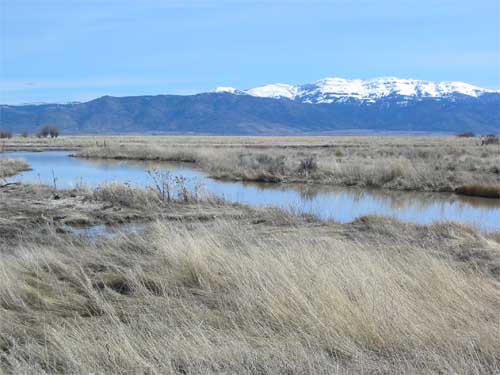Eastern Oregon Wetland Habitats
Few places in the western United States can boast the high numbers of waterfowl or vast wetland acreage found in southern and eastern Oregon. A casual look at this region leaves a visitor with the impression that it is dominated by high desert, typical of much of the Great Basin. Wet years result in large lakes with abundant emergent wetland vegetation, ideal habitat for waterfowl nesting and brood-rearing, while periodic drought cycles reduce the size of these wetlands, forcing waterfowl to find new habitat elsewhere. However, because of this dynamic cycle, these wetlands can be some of the most productive habitats for waterfowl. Although still producing and supporting literally millions of birds annually, this critical habitat has been severely impacted by land use patterns over the last 100 years. As a result, both the value of this habitat and the numbers of birds that use it have declined substantially. Ducks Unlimited is working diligently in the Klamath and Closed basins with a number of partners to reverse these declines.
|
|
| The Klamath Basin holds massive flocks of waterfowl |
Today, the majority of Klamath Basin wetlands have been converted to agricultural or other land uses, and the remaining wetlands have beem degraded by competing water demands. Only about 150,000 acres of wetlands remain in the basin, much of this within the Klamath Basin National Wildlife Refuge Complex. Intensive water developments have greatly reduced the quality of these remaining wetlands, decreasing their value to waterfowl. In addition, an over-allocated water supply has resulted in an enormous reduction in water available to flood fall habitat. Despite these modifications to its natural hydrology, the Klamath Basin remains critical to waterfowl and other migratory birds. Peak waterfowl counts in recent years have fluctuated around one to one and a half million ducks in the Klamath Basin each fall. The basin continues to provide abundant habitat for spring migration, during which up to 2 million pintails and 900,000 mallards can be counted.
 |
| The wetlands of the Oregon Closed Basin region are important for spring staging pintails. |
The Oregon Closed Basin, covering portions of Lake, Harney and Malheur Counties, contains more than 500,000 acres of wetlands. This region consists of distinct basins isolated by mountain ranges and high deserts. Some of the larger wetland basins include the Goose Lake, Warner, Summer Lake, Silver Lake, Harney Basin and Lake Abert basins. The area is characterized by very limited precipitation, and wetlands within in the region are subject to "feast-or-famine" water regimes. Because of this dynamic system, these basins contain very diverse wetland types that provide food, rest and shelter for a wide variety of nesting and migrating birds. Unfortunately, peak populations of over 2 million ducks can exploit the region's wetlands as stepping-stones during migration. Recent studies of the migration habits of northern pintails wintering in the Central Valley demonstrated the importance of the region for spring migrating pintails. Additionally, an estimated 40 percent of Pacific Flyway snow geese and Ross' geese depend on the Summer Lake and Harney Basin to provide the resources needed to reach their arctic breeding grounds each spring. Larger wetland complexes in the region can support tens of thousands of breeding waterfowl, including Canada geese, mallards, cinnamon teal, gadwall and redheads.
 |
| Ducks Unlimited conserves wetlands in eastern Oregon. |
Ducks Unlimited uses cookies to enhance your browsing experience, optimize site functionality, analyze traffic, and deliver personalized advertising through third parties. By continuing to use this site, you agree to our use of cookies. View Privacy Policy